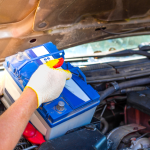No matter how careful you are, dents on your car are almost inevitable. Whether caused by a stray shopping cart, a minor collision, or a sudden hailstorm, car dents can diminish the appearance of your vehicle. Luckily, many dents can be repaired without a costly visit to the body shop. In this guide, we will explore everything you need to know about car dent repair, from understanding the types of dents to different repair methods, and tips on restoring your car’s body to its original condition.
Why Car Dent Repair is Essential
While you might be tempted to ignore small dents, it is essential to repair them promptly for several reasons. First, car dents can significantly lower your vehicle’s resale value. A smooth and pristine exterior is one of the key signs of a well-maintained car. Potential buyers are more likely to be attracted to a car that looks clean and dent-free than one with obvious imperfections.
Second, even minor dents can lead to more severe issues over time. If the paint is cracked or damaged, moisture can seep into the exposed metal, causing rust and corrosion. Addressing car dents early on prevents further deterioration and protects the body from long-term damage. Additionally, dent repair is necessary for maintaining your car’s overall visual appeal. Whether you’re a car enthusiast or simply take pride in the look of your vehicle, removing dents ensures that your car maintains its sleek appearance.
Understanding Different Types of Car Dents
Not all car dents are the same. Knowing the type of dent your car has can help you decide which repair method to use. Some of the most common types of dents include round dents, creased dents, sharp dents, and dings. Round dents are often caused by spherical objects like hailstones or debris, leaving a shallow, rounded depression on the car’s surface. Creased dents, on the other hand, are caused by sharp objects or accidents that result in a deep fold or line in the metal. These are more difficult to repair since the metal has been significantly deformed.
Sharp dents are typically caused by accidents that involve edges, leaving distinct lines and making them more challenging to repair without professional help. Finally, dings are minor dents, often caused by small objects like doors opening into your car in tight parking spaces. Dings are usually shallow and relatively easy to fix, making them perfect candidates for DIY repair methods.
DIY Car Dent Repair Methods
For small or shallow dents, many do-it-yourself methods can help fix the problem before seeking professional repair. One simple approach is using a plunger, which works particularly well for large, shallow dents on flat surfaces. By cleaning the dented area and using a wet plunger to create suction, you can gently pull the dent back into place. Repeating this process several times can often result in the dent popping back out.
Another method involves using boiling water, which is especially effective on plastic bumpers. The heat from the boiling water softens the plastic, making it easier to manipulate. After pouring the hot water over the dent, you can reach behind the panel and carefully push the dent out. To help the plastic retain its new shape, it’s advisable to run cold water over the area immediately after.
For metal surfaces, the hairdryer and compressed air technique is a popular option. By heating the dented area with a hairdryer for about a minute and then spraying the spot with compressed air, the sudden change in temperature can cause the dent to pop out due to the metal expanding and contracting. This method is most effective on small, shallow dents and is relatively simple to perform at home.
Another approach is using a dent puller, a tool specifically designed for removing car dents. A dent puller can be attached to the surface using either suction or adhesive, depending on the tool, and is pulled back to lift the dent. This method is ideal for larger, shallow dents where the metal hasn’t been creased. Dent pullers are a common DIY solution, but they may not be suitable for more complex dents or damage involving the paint.
When Professional Help is Necessary
While DIY methods can be effective for simple car dents, certain types of dents or damage require professional repair. Deep dents, creases, or dents that have cracked the paint should be handled by a professional. Paintless dent repair (PDR) is a service commonly offered by professionals to remove dents without damaging the original paint. PDR uses specialized tools to massage the dent from the inside out, leaving the paint untouched and restoring the body to its original shape.
For more severe damage, such as deep creases or dents with damaged paint, traditional dent repair may be necessary. This process often involves filling the dent, sanding the surface, and repainting the affected area to match the rest of the car. While this repair is more costly than PDR, it ensures a flawless finish and can help prevent future problems like rust.
Read More: Engine Diagnostics Made Easy: Skills and Tools You Need
Preventing Future Car Dents
While it’s impossible to avoid all car dents, there are several ways you can reduce the risk of them happening again. Parking your car in a garage or covered area will protect it from environmental factors like hail, falling branches, or debris. When parking in public areas, leaving enough space between your car and neighboring vehicles can help prevent door dings or accidental bumps from shopping carts.
Additionally, using door edge guards or investing in a car cover can offer extra protection. These simple measures can go a long way in minimizing future car dents and keeping your car’s exterior looking pristine.
Long-Term Maintenance for a Dent-Free Car
Keeping your car dent-free doesn’t have to be a difficult task. By addressing car dents quickly, you not only maintain your vehicle’s appearance but also prevent further issues like rust or paint damage. Whether you opt for DIY repair methods or seek professional assistance, regular dent maintenance will keep your car in excellent condition.
Taking preventive measures, such as careful parking and protecting your car from the elements, will reduce the chances of future dents. By staying proactive and repairing dents when they occur, you can preserve your car’s resale value and enjoy a sleek, smooth ride for years to come.











